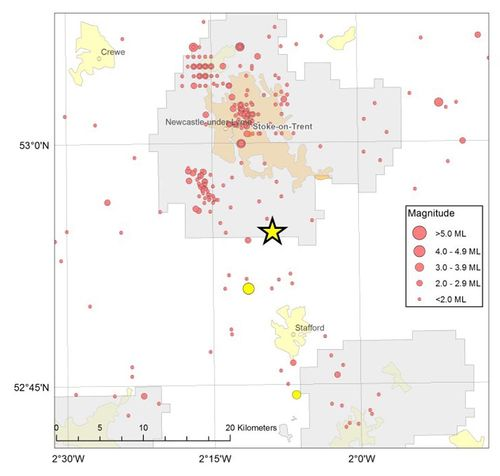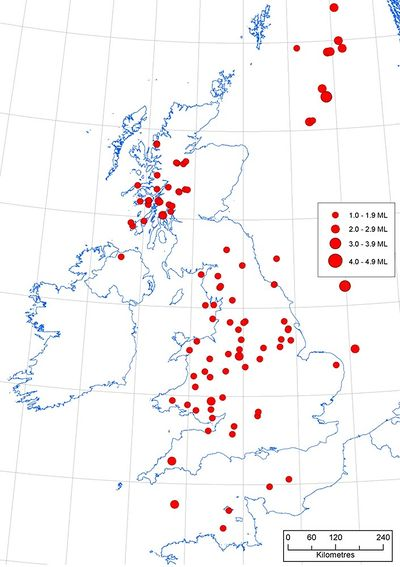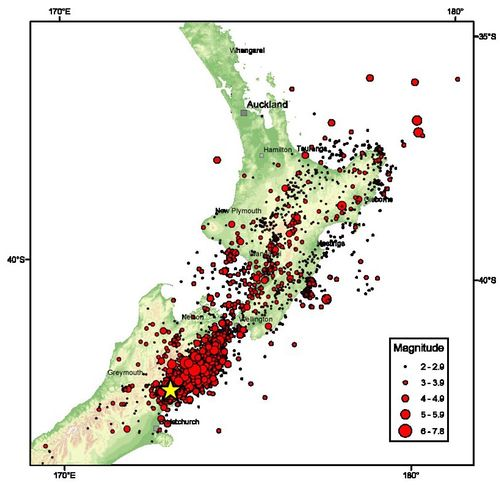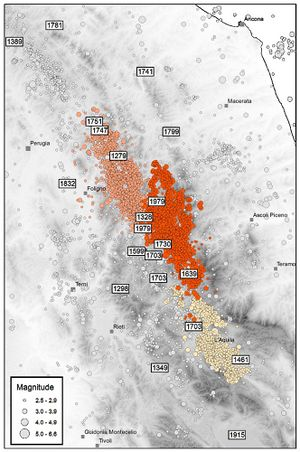OR/17/033 Seismic activity
| Baptie, B. 2017. Earthquake seismology 2016/2017 - BGS seismic monitoring and information service. British Geological Survey Internal Report, OR/17/033. |
The details of all earthquakes, felt explosions and sonic booms detected by the BGS seismic network have been published in monthly bulletins and compiled in the BGS Annual Bulletins.
There were 214 local earthquakes located by the monitoring network during 2016–2017, with 20 having magnitudes of 2.0 ML or greater, and five having magnitudes of 3.0 ML or greater. All of the latter occurred offshore. Four events with a magnitude of 2.0 ML or greater were reported felt, together with a further 16 smaller ones, bringing the total to 20 felt earthquakes in 2016–2017.

The largest felt earthquake was a magnitude 3.8 ML event on 3 January 2017. The epicentre was in the North Sea about 150 km east of Scarborough. It was only weakly felt in Scarborough.
The largest earthquake on mainland Britain during 2016–2017 was a magnitude 2.6 ML event near Stone, Staffordshire that occurred on 3 March 2017 at 09:28 UTC. The earthquake was only weakly felt by a few people near the epicentre, with a maximum intensity of 2 EMS.
A magnitude 2.3 ML earthquake on 27 October 2016 at 02:08 UTC was widely felt in Cornwall, with a maximum intensity of 3 EMS. The epicentre was on Bodmin Moor about 10 km east of Bodmin and 5 km northwest of Liskeard.

Overview of global earthquake activity
Worldwide, there were 15 earthquakes with magnitudes of 7.0 or greater and 137 with magnitudes of 6.0 or greater. These numbers are in keeping with longer term annual averages based on data since 1900, which suggest that on average there are 16 earthquakes with magnitude 7.0 or greater and 150 with magnitudes of 6.0 or greater each year. Deadly and destructive earthquakes included a magnitude 7 event on Kyushu in southwest Japan and a destructive sequence of earthquakes in Central Italy.

A magnitude 7.0 earthquake occurred on Kyushu, Japan on 15 April 2016. The epicentre was several hundred kilometres northwest of the Ryukyu Trench, where the Philippines plate is subducted beneath Japan and the Eurasia plate. The shallow depth and faulting mechanism of this earthquake suggest that it occurred on a crustal fault within the Eurasia plate.
Earthquakes at this depth are relatively unusual in this part of Japan, since most seismicity in the Kyushu region is related to the subduction of the Philippine plate and occurs at greater depths below the island. Just 13 M 5+ earthquakes have occurred at shallow depths (<50 km) within 100 km of the April 2016 events over the preceding century. A shallow M 6.6 earthquake in March 2005, just off the north coast of Kyushu and 110 km north of the April 2016 event, caused over 1000 injuries and at least one fatality.
The April 15 earthquake occurred one day after a series of foreshocks in the same region, which included magnitude 6.2 and 6.0 earthquakes.
A magnitude 7.8 earthquake struck the South Island of New Zealand on 14 November 2016. The epicentre was 60 kilometres south-west of the town of Kaikoura.

Two people died in the earthquake. Kaikoura was cut off due to landslides, damaged bridges and infrastructure, road subsidence, and the risk of falling debris. Many other major roads in the South Island were also closed because of landslides and damage to bridges. There was also widespread damage to buildings in the city of Wellington.
A complex rupture propagated north for over 200 km continuing offshore and resulting in a localised tsunami of up to 7 m. The largest surface displacements were near the northern termination of the earthquake rupture, at the northeast tip of the South Island. This may explain why aftershocks were concentrated in the north, and why areas north of the rupture, such as Wellington, experienced more damage than areas to the south.
A magnitude 6 earthquake occurred in Central Italy on 24 August, close to the towns of Accumoli and Amatrice. Despite the moderate magnitude, the shallow hypocentre resulted in severe ground shaking and significant damage to the many vulnerable buildings in the region, leading to 299 deaths. The village of Amatrice was devastated.
Two months later, on 26 October, a magnitude 5.9 event occurred on a fault segment 25 km to the north, near the town of Visso. A further four days later, on 30 October, a magnitude 6.5 earthquake, the largest of the sequence, struck the area in between the two previous events, destroying the town of Norcia and surrounding towns.
This was the largest earthquake to strike Italy since the 1980 magnitude 6.9 Irpinia earthquake. Fortunately, this event did not result in further casualties, mainly because local residents had already abandoned the previously damaged buildings.
All three events resulted from normal faulting along a 60 km fault zone zone that has been active in both historical and modern times (Chiaraluce et al., 2017[1]). This zone lies immediately north of the fault zone that ruptured during the 2009 L’Aquila earthquake sequence and overlaps with the southern end of the 1997 Colfiorito seismic sequence. The loss of life and the damage to buildings underline the pressing need to understand the complexity of the underlying physics of earthquake sequences, and to use this knowledge to anticipate the evolution of such sequences in the future.
References
- ↑ Chiaraluce, L, Di Stefano, R, Tinti, E, Scognamiglio, L, Michele, M, Casarotti, E, Cattaneo, M, De Gori, P, Chiarabba, C, Monachesi, G, Lombardi, A, Valoroso, L, Latorre, D, and Marzorati, S. 2017. The 2016 Central Italy Seismic Sequence: A First Look at the Mainshocks, Aftershocks, and Source Models. Seismological Research Letters, 88, 3.